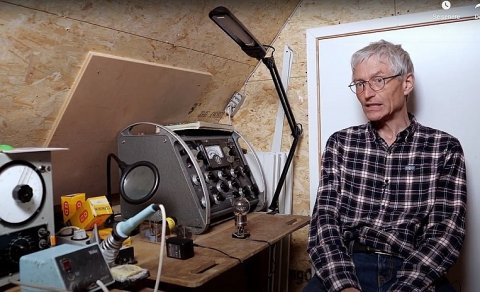___________________________________________________________________
Links
____________________________________________________________________
Erfaringer med rør
Bjarne Christensen, musiker og medlem af Hifiakademiet
Jeg synes at rør-området er rigtig fedt og jeg ved at det det har sin store berettigelse i musikbrancen, især på studiesiden (John G. Petersen ved det også) men på livesiden er det et must for (el) guitaristerne. Fender, Vox, Ampex, Marshall m.m. er sikker "fabriksstandard" på feltet. På basfronten hvor jeg mest er, er det lidt mere problematisk, pga. behovet for de meget store effekter der er nødvendige for at hamle op med alle de andre kraftige lydkilder der er på scenen. Der er stadig enkelte der holder stædigt fast i at bruge de store rørtoppe som spiller godt men som vejer op imod 40 kg.
_____________________________________________________________________
Tubes versus Solid State
The tube versus transistor debates that you hear most often occur in the pages of consumer and music magazines, with descriptive, but imprecise language like “warm”, “liquid”, “smooth”, and “dynamic”.
But what do the engineers who actually design the equipment think about tubes versus transistors in terms of objective science and measurements?
The two professional societies that have the most to say on this subject are the IEEE (Institute of Electrical and Electronics Engineers) and the AES (Audio Engineering Society). Both of these professional societies publish peer-reviewed journals, with articles written by engineers and scientists who work in the professional and consumer audio industry, as well as in cutting-edge academic research. If you are seeking a balanced view on this debate, direct yourself to either or both of these societies.
Below we point you to some readily available IEEE and AES publications that will help you better understand the differences between solid-state and vacuum tube electronics, their performance, and ultimately their sound.
IEEE - The Cool Sound of Tubes
The IEEE published “The Cool Sound of Tubes” in their August 1998 issue of IEEE Spectrum. In the same article, there is also a useful sidebar on tube versus transistor distortion. Finally, there is a useful table summarizing the advantages and disadvantages of tubes and transistors from both sonic and design points of view. Since the table is only available as a graphic image, we transcribe the text from the summary table below while highlighting some of the key points that directly impact sound quality:
Vacuum tubes – Advantages
Highly linear without negative feedback, specially some small-signal types
Clipping is smooth, which is widely considered more musical than transistors
Tolerant of overloads and voltage spikes
Characteristics highly independent of temperature, greatly simplifies biasing
Wider dynamic range than typical transistor circuits, thanks to higher operating voltages.
Device capacitances vary only slightly with signal voltages
Capacitive coupling can be done with low-value, high-quality film capacitors
Circuit designs tend to be simpler than semiconductor equivalents
Operation is usually in Class A or AB, which minimizes crossover distortion
Output transformer in power amp protects speaker from tube failure
Maintenance tends to be easier because user can replace tubes.
Vacuum tubes – Disadvantages
Bulky, hence less suitable for portable products
High operating voltages required
High power consumption, needs heater supply
Generate lots of waste heat
Lower power efficiency than transistors in small-signal circuits
Low-cost glass tubes are physically fragile
More prone to microphonics than semiconductors, especially in low-level stages
Cathode electron-emitting materials are used up in operation, resulting in shorter lifetimes (typically 1-5 years for power tubes)
High-impedance devices that usually need a matching transformer for low impedance loads, like speakers
Usually higher cost than equivalent transistors
Transistors – Advantages
Usually lower cost than tubes, especially in small-signal circuitsSmaller than equivalent tubes
Can be combined in one die to make integrated circuitLower power consumption than equivalent tubes, especially in small-signal circuitsLess waste heat than equivalent tubes
Can operate on low-voltage supplies, greater safety, lower component costs, smaller clearances
Matching transformers not required for low-impedance loadsUsually more physical ruggedness than tubes (depends on chassis construction)
Transistors – Disadvantages
Tendency toward higher distortion than equivalent tubes
Complex circuits and considerable negative feedback required for low distortionSharp clipping, in a manner widely considered non-musical, due to considerable negative feedback commonly used
Device capacitances tend tovary with applied voltages
Large unit-to-unit variations in key parameters, such as gain and threshold voltageStored-charge effects add signal delay, which complicates high-frequency and feedback amplifier designDevice parameters vary considerably with temperature, complicating biasing and raising the possibility of thermal runaway
Cooling is less efficient than with tubes, because lower operating temperature is required for reliability
Power MOSFETs have high input capacitances that very with voltage
Class B totem-pole circuits are common, which can result in crossover distortionLess tolerant of overloads and voltage spikes than tubes
Nearly all transistor power amplifiers have directly-coupled outputs and can damage speakers, even with active protection
Capacitive coupling usually requires high-value electrolytic capacitors, which give inferior performance at audio-frequency extremes
Greater tendency to pick up radio frequency interference, due to rectification by low-voltage diode junctions or slew-rate effects
Maintenance more difficult; devices are not easily replaced by user
Older transistors and ICs often unavailable after 20 years, making replacement difficult or impossible.

